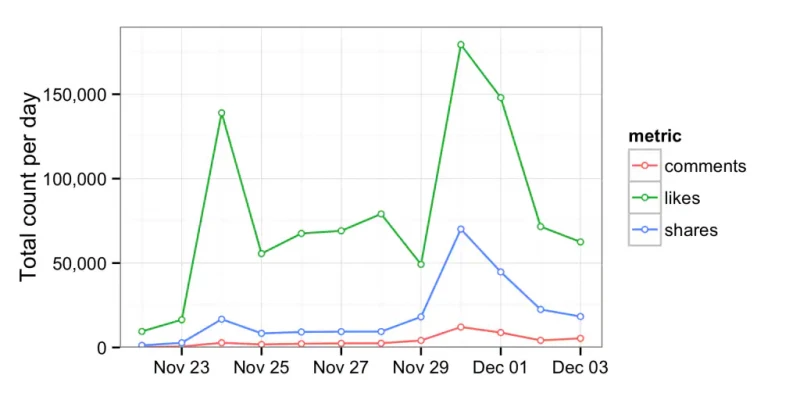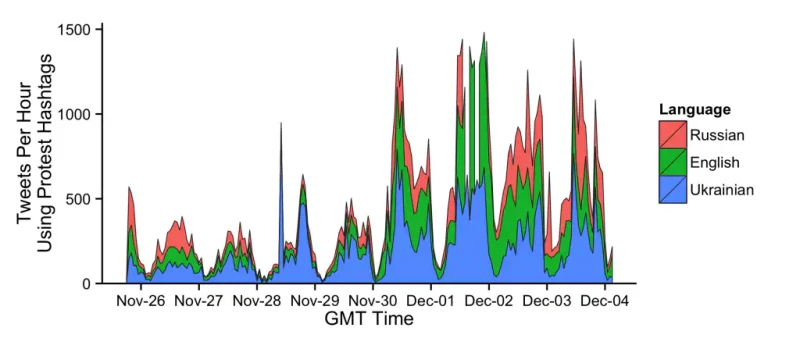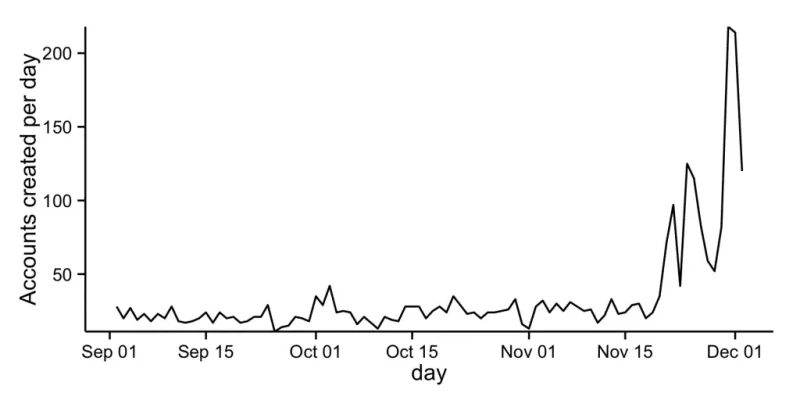How Ukrainian Protestors are Using Twitter and Facebook
We collected tweets mentioning the most common Twitter hashtags and available Facebook data of the Kiev protest since the morning of November 25, and found that Ukrainian social media users are strategically using the tools available to them to organize and spread information about the protests.

Credit: Wikipedia Commons
Authors
Area of Study
This article was originally published at The Washington Post.
*****
Protests on the streets of Kiev, and in other cities across the Ukraine, have been ongoing now for two weeks. Organized in response to a decision on the part of the Ukrainian government to move towards closer ties with Russia, and away from strengthening the relationship with the European Union, the protests are the largest in Ukraine since the Orange Revolution in 2004. On Sunday, the largest day of protests so far, The Guardian estimates that over 300,000 people were on the streets of Kiev pushing for a move towards Europeanization, and away from Russia. Several days into the protests, some protesters are calling for an outright revolution, and Monday a motion for a vote of no confidence on the part of the opposition in parliament failed to pass. Many believe that Russia pressured President Yanukovych to back out of a deal with the EU last week, which would have improved trade relations between the country and the Union.
As with many recent protests, there has been much conversation about the role that social media has played in Ukraine. An article in the Kyiv Post argued that social media had played a critical role. At the Social Media and Political Participation (SMaPP) lab at NYU, we have been collecting all tweets mentioning the most common Twitter hashtags of the protest since the morning of Monday, Nov. 25, as well as data on public Facebook activity. What can we learn from these digital traces about the role of social media in the Ukrainian protests?
The first notable trend is that Facebook is being used much more actively than Twitter. The official EuroMaidan Facebook page, started on Nov. 21, now has over 126,000 likes. Almost all of the information on this page is in Ukrainian, suggesting that the information is geared to locals rather than the international community, and there is evidence of vibrant interaction. As we have observed in other cases, this type of pages serves a dual purpose: to provide information about the ongoing protests to individuals who are not participating, and to coordinate protestors. A look at the most popular Facebook posts on this page confirms this intuition: many posts provide news updates that generate intense discussions, but the page is also used to provide important logistical information for protestors. There are, for example, posts with maps of places to get free tea and access to warm spaces, advice on how to avoid being provoked by government agents, flyers to print and distribute around the city, as well as information on where protesters will be gathering.
Most importantly, people are interacting with this information. The 2000 updates posted on the page since it was created have garnered close to 50,000 comments and over a million likes; and their content has been shared over 230,000 times. The plot below illustrates the number of daily likes (on posts), comments, and shares on the page since its creation. Here we can see that there are spikes in activity during both weekends, when protests were the largest, as well as an increase over time in the level of activity. The most widely shared posts include several with videos of police violently beating protestors with batons, another urging workers in various capacities in the government and outside it to stop working and join the protests, and one which includes quotes from Mykhailo Zhurovsky, the rector of the largest university in the country (Kyiv Polytechnic), supporting the protests. Finally, a second Facebook page was created on Nov. 30 particularly to provide legal assistance to protestors. This page has garnered 16,677 likes in 3 days.

Twitter usage is much lower, with a total of 120,000 tweets having been sent mentioning the main hashtag of the protest (and its Russian and English translations) since we began collecting data, with numbers peaking on Sunday, Dec. 1, the largest day of the protests. An interesting difference in comparison with other protests is the fragmentation in the language of the tweets, with Ukrainian accounting for only 33 percent, English for 28 percent and Russian for 24 percent.
However, if we examine the geographic distribution of the active users on Twitter, we find that 69 percent of geolocated users are tweeting from Ukraine, many of them writing in English, which suggests that this result is not driven primarily by foreign users. One possible explanation for this result is a division of purposes across social media: while Facebook is used to create content targeted to a domestic audience, Twitter appears to be a tool to convey information about the protest to the rest of the world and to draw the attention of the international community. This result is consistent with some of the work by Sean Aday and colleagues on their paper “Blogs and Bullets”.

Perhaps the most interesting trend on Twitter is the spike in user registration. The plot below shows the distribution of the dates in which social media users participating in the protest through this platform opened their account. We observe a significant spike in account creation coinciding exactly with the onset of the protests. In other words, this plot suggests many of those using the EuroMaidan hashtags (евромайдан, євромайдан, and euromaidan) are new Twitter users. In fact, of the 34,000 unique users posting about the protests, 1,200 of them are users who have joined since the protests started. This suggests that the protests themselves are encouraging Ukrainians to join and begin using Twitter, perhaps influenced by having seen the impact of Twitter in other recent protests and recognizing the strategic potential of the medium, particularly for communicating with those outside of the country.

Taken together, our data suggests that Ukrainian social media users are strategically using the tools available to them in the ways that seem most effective. The disparity in language use between Facebook and Twitter suggests an understanding on the part of users about the audiences consuming the content they produce in each medium. The spike in Twitter use is, to our knowledge, a previously unobserved phenomenon. It suggests a reciprocal relationship between social media and protest, where social media can serve as an important strategic tool for protest, and at the same time attract new users to online communication platforms.